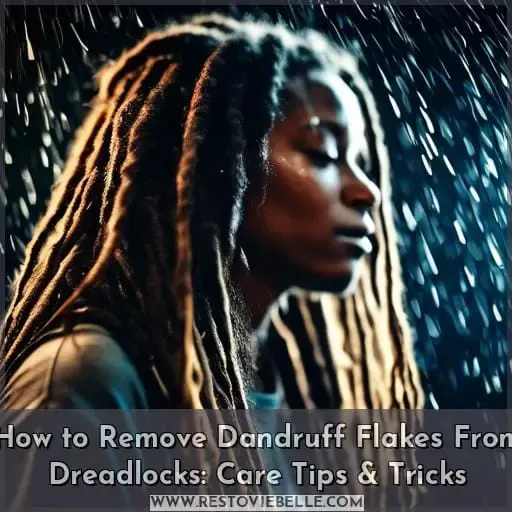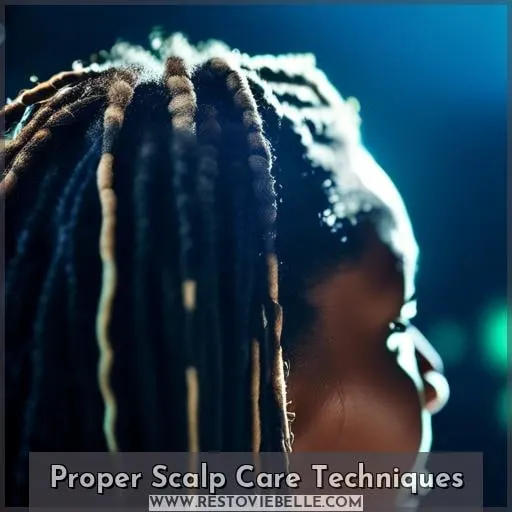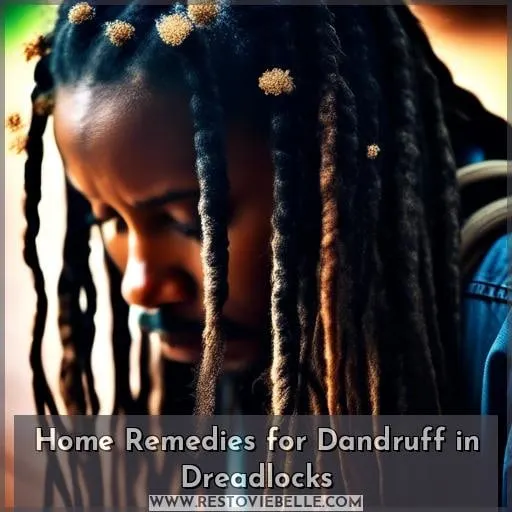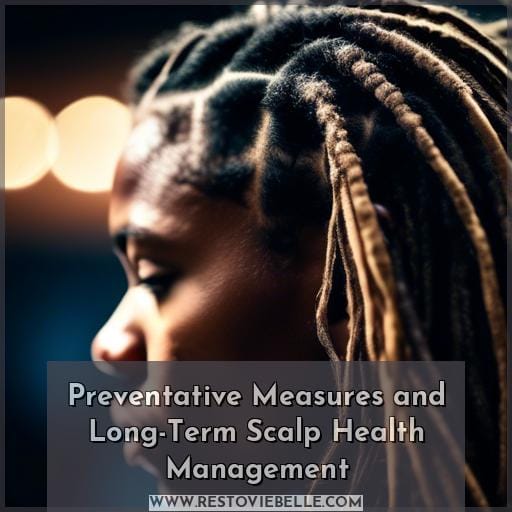This site is supported by our readers. We may earn a commission, at no cost to you, if you purchase through links.
 Battling dandruff in dreadlocks can feel like navigating through a stormy sea of flakes.
Battling dandruff in dreadlocks can feel like navigating through a stormy sea of flakes.
Dandruff, often caused by the Malassezia yeast, improper drying, or excessive sebum production, can turn managing dreadlocks into a daunting task. Fear not, as this guide will arm you with the knowledge and tools to effectively remove dandruff flakes from your dreadlocks.
From understanding the root causes to selecting the right anti-dandruff shampoo and employing home remedies, we’ll explore comprehensive care tips and tricks. Dive into proper scalp care techniques and preventative measures to ensure long-term scalp health and keep your dreadlocks looking their best.
Yes, you can remove dandruff flakes from dreadlocks by using a good anti-dandruff shampoo and following the instructions on the bottle. Regular washing and possibly changing your diet to include probiotics can also help manage dandruff.
Table Of Contents
- Key Takeaways
- Identifying the Causes of Dandruff in Dreadlocks
- Proper Scalp Care Techniques
- Selecting the Right Anti-Dandruff Shampoo for Dreadlocks
- Home Remedies for Dandruff in Dreadlocks
- Preventative Measures and Long-Term Scalp Health Management
- Frequently Asked Questions (FAQs)
- Can I use hair dye on my dreadlocks without exacerbating dandruff issues?
- How often should I replace my dreadlock maintenance tools to prevent dandruff?
- Are there specific dietary changes that can help reduce dandruff for individuals with dreadlocks?
- How can I tell if my dandruff is caused by a fungal infection or just dry scalp?
- Is it safe to use heat styling tools on dreadlocks if I have a dandruff problem?
- Conclusion
Key Takeaways
- Utilize anti-dandruff shampoos containing active ingredients like salicylic acid, ketoconazole, or tea tree oil to combat yeast overgrowth and reduce flakiness.
- Regularly wash dreadlocks following a consistent routine, adjusting frequency based on hair type, and ensure thorough drying to prevent product buildup and excess moisture that can exacerbate dandruff.
- Apply natural remedies such as apple cider vinegar rinses or tea tree oil scalp applications to provide antiseptic benefits and help maintain scalp health.
- Maintain overall scalp health through hydration, a balanced diet, stress management, and replacing maintenance tools every 1-2 years to prevent long-term issues with dandruff.
Identifying the Causes of Dandruff in Dreadlocks
You might be wondering why your dreadlocks are plagued by dandruff. The answer could lie in an overgrowth of Malassezia yeast, which naturally resides on the scalp but can cause irritation when it proliferates excessively.
Additionally, if you’re not drying your locks thoroughly, you’re creating a hospitable environment for this fungus. Moreover, an overproduction of sebum, the scalp’s natural oil, can exacerbate the issue by providing more food for the yeast to thrive on.
It’s essential to address these factors to maintain a healthy scalp.
Malassezia Yeast Overgrowth
Dandruff in dreadlocks can often stem from an overgrowth of Malassezia yeast, a natural fungus that thrives on the oils your scalp produces.
If you’re noticing more flakes, it could be due to this fungal infection, which disrupts the delicate balance of your scalp’s microbiome.
To tackle yeast growth, it’s crucial to maintain a healthy scalp environment and manage sebum production. Remember, a scalp that’s out of balance is a playground for dandruff-causing fungi.
Improper Drying Techniques
When caring for dreadlocks, improper drying techniques can lead to several issues that exacerbate dandruff.
- Overdrying: Using high heat for too long can strip your scalp of natural oils, leading to dryness and flaking.
- Moisture Trapping: Dreadlocks can hold water, and if not dried thoroughly, trapped moisture can cause mildew and unpleasant odors.
- Matting: Damp dreadlocks are prone to matting, which can cause tension on the scalp and contribute to flaking.
- Root Rot: Persistent dampness at the roots may lead to fungal growth, known as ‘root rot’, damaging both scalp and hair.
- Scalp Irritation: A moist environment is ideal for bacteria, which can irritate the scalp and increase dandruff.
To maintain scalp health, ensure your dreadlocks are dried completely after washing, using a combination of air drying and gentle heat if necessary. Avoid covering your dreadlocks with caps or scarves until they’re fully dry to prevent moisture-related complications.
Excessive Sebum Production
Excessive sebum production can lead to dandruff in dreadlocks, as it creates an environment for yeast to thrive. Hormonal fluctuations often trigger this overproduction. To combat this, understand your scalp’s needs and avoid product buildup, which can exacerbate the issue.
| Cause | Solution |
|---|---|
| Hormonal Changes | Consult a dermatologist |
| Product Buildup | Use clarifying shampoo |
| Scalp Sensitivity | Choose gentle products |
Addressing these factors can help alleviate dry scalp and reduce scalp inflammation.
Proper Scalp Care Techniques
Understanding the root causes of dandruff in dreadlocks is crucial, but it’s equally important to know how to maintain a healthy scalp.
- Scalp Exfoliation: Regularly exfoliating your scalp can help remove dead skin cells and product buildup, which are common culprits of dandruff. Use gentle exfoliating products or tools to avoid damaging your scalp or dreadlocks.
- Balanced Moisturization: Keep your scalp moisturized but not overly oily. Coconut oil is a natural moisturizer that can help maintain the balance of your scalp’s hydration without contributing to excess sebum production.
- Natural Remedies: Incorporate natural ingredients with antifungal and antibacterial properties, such as tea tree oil and apple cider vinegar, into your scalp care routine. Dilute these substances properly to avoid irritation.
- pH Regulation: Baking soda can help balance the pH of your scalp, which may contribute to reducing dandruff. However, it should be used cautiously to prevent over-drying the scalp.
By integrating these techniques into your hair care regimen, you can create an optimal environment for scalp health, which is essential for keeping dandruff at bay. Remember, consistency is key, and it’s always best to tailor your scalp care to your specific needs and responses.
Selecting the Right Anti-Dandruff Shampoo for Dreadlocks
When selecting the right anti-dandruff shampoo for dreadlocks, it’s crucial to focus on effective ingredients, moisturizing qualities, and scent considerations.
Look for shampoos containing ingredients like salicylic acid, ketoconazole, or tea tree oil, which are known for their dandruff-fighting properties.
Ensure the shampoo also has moisturizing elements such as aloe vera or coconut oil to prevent your locs from drying out.
Lastly, consider the scent, as some anti-dandruff shampoos may have strong odors; opt for products with natural fragrances to keep your dreadlocks smelling fresh.
Effective Ingredients
When selecting an anti-dandruff shampoo for your dreadlocks, prioritize products with proven anti-fungal properties.
Salicylic acid is a keratolytic agent that aids in shedding dead skin cells, effectively reducing flakiness.
Zinc pyrithione targets the fungus that causes dandruff, offering relief from scalp irritation.
Tea tree oil, with its natural antiseptic qualities, can soothe an itchy scalp and combat dandruff.
Coal tar, although potent, should be used cautiously due to its strong odor and potential to stain.
These ingredients, when combined in a shampoo, can help you maintain a healthy, flake-free scalp.
Moisturizing Qualities
After discussing the importance of effective ingredients in your anti-dandruff shampoo, let’s delve into the significance of moisturizing qualities. Keeping your scalp hydrated is crucial, especially when managing dreadlocks. Moisturizing oils and scalp conditioners play a pivotal role in preventing dryness and flakiness.
- Moisturizing Oils: Opt for shampoos infused with natural oils like avocado or castor oil, known for their deep moisturizing properties.
- Scalp Conditioners: Seek out formulas that include soothing serums or conditioners to calm the scalp and reduce itchiness.
- Anti-Itch Treatments: Look for ingredients like peppermint or tea tree oil, offering relief from itchiness while providing a refreshing sensation.
Selecting a shampoo with these moisturizing qualities ensures your dreadlocks remain healthy, hydrated, and free from dandruff flakes.
Scent Considerations
When selecting the right anti-dandruff shampoo for your dreadlocks, don’t overlook scent considerations.
Fragrance in haircare products, while appealing, can be a double-edged sword. For those with scent sensitivity, fragrances are a common trigger for scalp irritation. Opting for fragrance-free options can mitigate this risk, ensuring your scalp remains healthy and irritation-free.
However, if you prefer scented products, consider shampoos infused with natural essential oil blends. These can offer a pleasant aroma without the harsh effects of synthetic fragrances, contributing positively to both hair health and sensory experience.
Home Remedies for Dandruff in Dreadlocks
When tackling dandruff in dreadlocks, don’t overlook the power of home remedies. These natural solutions can be both effective and gentle on your scalp and locs.
Apple cider vinegar is a standout choice for its ability to balance the scalp’s pH and combat yeast overgrowth, a common dandruff culprit. A simple rinse can remove buildup and soothe your scalp. Tea tree oil, with its antifungal and antibacterial properties, is another ally. It can alleviate scalp irritation and prevent dandruff when diluted and applied to the scalp.
Baking soda offers a deep cleansing action, removing stubborn buildup from your locs. When used in moderation, it can significantly improve scalp health. Lemon juice, known for its antiseptic qualities, can also help in maintaining a clean and healthy scalp when used sparingly.
Lastly, yogurt serves as a moisturizing and anti-inflammatory agent, helping to soothe the scalp and reduce flakiness. Applying it directly to the scalp before rinsing can provide relief from dandruff symptoms.
Incorporating these remedies into your hair care routine can lead to healthier dreadlocks and a dandruff-free scalp.
Preventative Measures and Long-Term Scalp Health Management
Maintaining a healthy scalp is crucial for preventing dandruff in dreadlocks. To ensure long-term scalp health, focus on hydration and exfoliation. Drink plenty of water to keep your scalp and hair hydrated from the inside out. Use gentle exfoliating techniques to remove dead skin cells without causing irritation.
Pay attention to your diet, as it can significantly impact your scalp’s condition. Foods rich in vitamins and minerals support skin health, so include plenty of fruits, vegetables, and healthy fats in your meals.
Stress management is also essential; high stress levels can disrupt your body’s natural balance, affecting your scalp’s health. Find stress-reducing activities that work for you, such as yoga, meditation, or exercise.
Lastly, maintain good hygiene with a consistent washing routine using residue-free shampoos designed for dreadlocks. Ensure your dreadlocks are completely dry after washing to prevent fungal growth, which can exacerbate dandruff issues.
By adopting these preventative measures, you can promote long-term scalp health and keep dandruff at bay.
Frequently Asked Questions (FAQs)
Can I use hair dye on my dreadlocks without exacerbating dandruff issues?
You can dye dreadlocks, but it’s crucial to choose dye carefully to avoid aggravating dandruff.
Opt for gentle, non-irritating products and perform a patch test beforehand.
How often should I replace my dreadlock maintenance tools to prevent dandruff?
To prevent dandruff, replace dreadlock maintenance tools every 1-2 years or sooner if they show wear.
Regular cleaning of these tools is also crucial.
Are there specific dietary changes that can help reduce dandruff for individuals with dreadlocks?
A staggering 72% of individuals with severe scalp conditions believe their diet influences their symptoms.
To combat dandruff, especially in dreadlocks, incorporating foods rich in zinc, biotin, and healthy fats like omega-3 fatty acids is crucial.
These nutrients, found in salmon, eggs, and avocados, help regulate sebum production and maintain scalp health.
How can I tell if my dandruff is caused by a fungal infection or just dry scalp?
To discern if your dandruff stems from a fungal infection or merely dry scalp, observe the flakes and scalp condition.
Fungal dandruff typically presents as oily, large flakes, possibly with red, scaly skin, while dry scalp features smaller, dry flakes.
A medical professional can provide a definitive diagnosis.
Is it safe to use heat styling tools on dreadlocks if I have a dandruff problem?
Using heat styling tools on dreadlocks when battling dandruff is like walking a tightrope without a safety net; it’s risky.
Heat can exacerbate scalp dryness, leading to more flaking.
Opt for gentle, moisturizing care instead.
Conclusion
Nearly 50% of adults experience dandruff at some point in their lives, making it a common yet manageable condition. When it comes to removing dandruff flakes from dreadlocks, the journey requires patience and the right approach.
By understanding the causes, such as Malassezia yeast overgrowth, improper drying, and excessive sebum production, you’re already a step ahead. Regularly washing your dreadlocks with a suitable anti-dandruff shampoo, incorporating moisturizing and effective ingredients, can significantly reduce flakiness.
Don’t overlook home remedies and essential oils for added scalp care. Remember, maintaining long-term scalp health involves not just treatment but also preventative measures to ensure your dreadlocks remain vibrant and flake-free.











